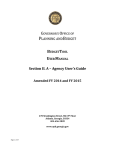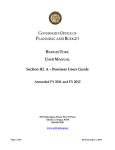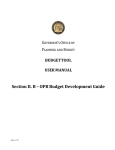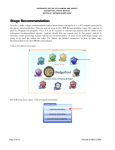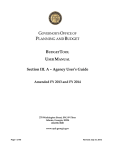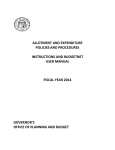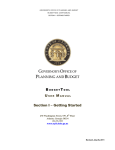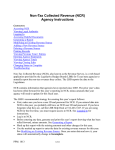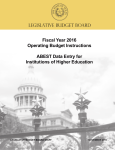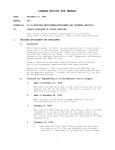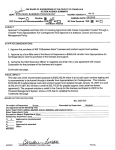Download BudgetTool Manual-Section II.A
Transcript
GOVERNOR’S OFFICE OF PLANNING AND BUDGET BUDGETTOOL USER MANUAL Section II. A – Agency User’s Guide 270 Washington Street, SW, 8th Floor Atlanta, Georgia, 30334 404-656-3820 www.opb.georgia.gov Page 1 of 36 GOVERNOR’S OFFICE OF PLANNING AND BUDGET BUDGETTOOL USER MANUAL SECTION II.A - AGENCY USER’S GUIDE Preface The purpose of the BudgetTool User Manual is to provide detailed instructions for using the BudgetTool application. All agencies will use BudgetTool to submit their Amended and General budget requests to the Governor’s Office of Planning and Budget (OPB). The manual is divided into sections: Section I: Getting Started – This section contains general orientation and instructions on: Technical Requirements Application Setup Access Navigation Overview It is anticipated that Section I will be read first as these instructions are not repeated in the following sections and apply to all users of the application. Section II.A: Agency User’s Guide – This section contains detailed instructions on the business processes and how to use the application to develop an agency’s budget request, submission by the agency, and workflow through the Governor’s Recommendation to the General Assembly. Section II.B: OPB Budget Development Guide – This section contains detailed instructions for the OPB Analysts to be used in developing the OPB Recommendation. Section III: Performance Measures – this section contains instructions for agencies to enter and update performance measures in BudgetTool. These will appear in the Governor’s Budget Report. Section II: Agency User’s Guide Purpose The purpose of this section of the BudgetTool User Manual is to provide instructions for the specific business processes for the current budget cycle as well as instructions of how to use BudgetTool to develop the Amended and General agency budget request. This part of the manual incorporates both business and technical instructions. While it is anticipated that the application will not change dramatically from year to year, only use those business instructions that apply to the budget year being worked on as the business processes more than likely will change from year to year. II. A: Agency Budget Request The Agency Request is prepared using the BudgetTool application. Agencies will use descriptors to enter fund source and object class changes by program/subprogram. The AOB or an approved cutoff amendment is selected as the starting point for budget requests and changes are made using descriptors. Any Statutory, Fiscal Affairs, or Executive Order amendment types in BudgetNet should be included in the cutoff amendment. Data will be advanced from the cutoff amendment in summary except for the following record detail: Federal Funds, Federal Recovery Funds, Other Funds, Personal Services, and Unique Objects. The same base will be used for both the Amended and General budgets. The base is advanced from BudgetNet to BudgetTool but State Funds – Prior Year Page 2 of 36 GOVERNOR’S OFFICE OF PLANNING AND BUDGET BUDGETTOOL USER MANUAL SECTION II.A - AGENCY USER’S GUIDE are not advanced. OPB analysts will ensure BudgetTool reflects the appropriate base budget for these requests. NOTE: General Policy Guidelines and Preparation Procedures for budget preparation are posted on the OPB website at http://www.opb.georgia.gov. II.A.1 General Instructions – The Amended and General budgets require each agency to submit the same level of funding that is appropriated for the current fiscal year. Budget requests for additional funds will be allowed only for growth, workload and enrollment driven programs. The budget submission process in BudgetTool consists of the following components: 1. Base Budget (pre-approved by OPB) 2. One-Time Deletes 3. Revised Base Budget 4. Workload (only agencies designated by OPB ) 5. Redistributions (optional) 6. Other Adjustments (as required) Base Budget The Base Budget should be either the AOB or an approved cut-off amendment which will include Statutory, Fiscal Affairs, or Executive Order amendments to date in BudgetNet. The same base is used for the Amended and General budget requests. One-Time Deletes One-Time Deletes are non-recurring items of expenditure that are considered one time purchases in the current fiscal year and are deleted from the base. These will be provided by OPB and will reduce the budget request. Revised Base Budget The Revised Base is the Base Budget less any One-Time Deletes. Workload Additional funds will be allowed only for growth, workload and enrollment driven programs. Funding to be included as Workload increases will be communicated to agencies by OPB prior to budget submission. Redistribution To address additional expenditure needs, agencies must identify resources from within the current budget and redistribute funds as necessary. Provide a complete description for all budget Page 3 of 36 GOVERNOR’S OFFICE OF PLANNING AND BUDGET BUDGETTOOL USER MANUAL SECTION II.A - AGENCY USER’S GUIDE redistributions and explain the impact on service delivery and performance of the program using the BudgetTool application. Redistribution among object classes and among sub-programs within a program should be requested as an amendment to the current budget and should NOT be included as part of the agency’s Amended or General budget request. However, requests for redistribution of funds between programs must be submitted in BudgetTool as part of the budget request. Agencies are expected to manage their expenditure needs through the flexibility provided in program budgeting. The total of all redistributions and increased funding needs must net to zero. Positions and motor vehicles redistributed from one program to another should be reflected in the position and motor vehicle counts for the programs affected. Other Adjustments Other Adjustments include those not covered by the other change types. Business Process The business process sequence for budget development is as follows: Base: The agency fiscal officer selects the AOB or an approved cutoff amendment as their base, and then notifies the OPB Analyst. The base should include all Statutory, Fiscal Affairs, and Executive Order amendments to date in BudgetTool. The base is advanced from BudgetNet to BudgetTool. State Funds – Prior Year are not advanced. This base is fixed and cannot change through the budget development cycle. Before entering any changes, reports for the cutoff amendment should be run in both BudgetNet and BudgetTool for comparison to confirm by program and fund source that the proper amounts were loaded. One-Time Delete: These are items included in the current fiscal year budget that are onetime occurrences, and therefore, must be removed from this year’s request. These are always negative and will reduce the agency request upon submission to OPB. Workload: Requests for additional funds or workload increase pertain only to those agencies with growth, workload and enrollment driven programs. Redistributions: Agencies will use the redistribution change type to fund any enhancements needed by moving the necessary funds from other programs. The sum of all the redirect redistribution for an agency must equal zero by fund source. Other Adjustments: Adjustments not covered by any of the other change types. NOTE: BudgetTool validation for the budget plan which is to equal the amount of funding appropriated in the current fiscal year is not applicable for the Legislative and Judicial Branch agencies or for any other programs that may be exempt. Page 4 of 36 GOVERNOR’S OFFICE OF PLANNING AND BUDGET BUDGETTOOL USER MANUAL SECTION II.A - AGENCY USER’S GUIDE II.A.2 Creating an Agencywide or Standard Descriptor List There are three types of descriptors in BudgetTool: Statewide – descriptors that are setup by OPB but can be used by agencies. Primarily these are for changes that will be universal throughout the state regardless of agency or program. However, in some instances OPB may setup statewide descriptors that are agency specific and/or program specific but requires a different percentage or different wording than the descriptor used by all other agencies. Agencywide – descriptors that are set up by the agency; special security role is needed; can be used by the entire agency. These are for changes within an agency that may apply to numerous programs. Standard – descriptors that can be setup by the agency administrator or agency analyst. These are intended to be used for specific program changes. Agencywide and Standard descriptors can be set up at one time by the agency administrator before the change entries are done or agency analysts can set up standard descriptors as they make change entries. All descriptors – Statewide, Agencywide, and Standard - can be accessed from a dropdown list when change entries are made. A descriptor is the collection of information about the change that is being requested. It is the key to communicating throughout the entire budget process what is being requested, why, and what effect it will have on customers and deliverables. Descriptors are also what appear in the Governor’s Budget Report. Therefore, care should be taken to provide as much detail as necessary to enable other users of the information to have a clear understanding of what is being requested. If needed, agencies may attach documents to support a program, object class or fund source change. A descriptor can only be deleted in the stage it was created. In other words, an agency request descriptor cannot be deleted in the OPB Recommendation stage or beyond. When a descriptor is deleted all entries for all programs, funds sources, object classes, and counts are also deleted. If you want to delete a change entry for a single program and that is the only place the descriptor is used then it is correct to delete the descriptor. However, if the descriptor is used on multiple programs and you delete it trying to delete a specific entry, all entries will be deleted. Delete with caution. A. To set up Agencywide or Standard descriptors in advance, click the Agency Setup Shield Page 5 of 36 GOVERNOR’S OFFICE OF PLANNING AND BUDGET BUDGETTOOL USER MANUAL SECTION II.A - AGENCY USER’S GUIDE A. B. Click Standard and Agencywide Descriptor List B. C. Select Budget Year, Stage, and Agency and click Get List of Descriptor Refer to Section II.A.3.C.4.2 Adding a New Descriptor This shows the list of all descriptors that have been entered by the agency – standard and agencywide. Page 6 of 36 GOVERNOR’S OFFICE OF PLANNING AND BUDGET BUDGETTOOL USER MANUAL SECTION II.A - AGENCY USER’S GUIDE II.A.3 Creating a Change Entry A. Click the Change Selection Shield A. Page 7 of 36 GOVERNOR’S OFFICE OF PLANNING AND BUDGET BUDGETTOOL USER MANUAL SECTION II.A - AGENCY USER’S GUIDE B. Change Selection Screen a. Select the Budget Year from the drop down box b. Select the appropriate Stage and Agency from the drop down box Click Include attached agencies checkbox if you would like to include attached agencies in the program list. c. Click Show Programs d. The program list populates (d.). Double-click the Program or highlight the Program and click the (d.1) Program/Sub Program Change View button to view the various entries within their individual categories – Funds, Object Class and Counts. Or highlight the Program and click the (d.2) Program/Sub Program Change Entry button at the bottom of the page to open the change entry Summary Screen. a. b. c. d. d.1 d.2 Page 8 of 36 GOVERNOR’S OFFICE OF PLANNING AND BUDGET BUDGETTOOL USER MANUAL SECTION II.A - AGENCY USER’S GUIDE C. Agency Program/Sub Program Change Entry Screen The Change Entry screen gives the user a current view of all program changes entered in total to the Fund Sources and Object Classes side by side as well as changes to Position and Motor Vehicle counts. This screen can be opened for stand-alone programs, sub-programs, and parent programs. When opened for a parent program you will not be able to make change entries. In addition, the user can click on any of the detail buttons at the bottom of the screen to see the details for: State Funds, Federal Funds, Federal Recovery Funds, Other Funds, Personal Services (Object Class 300), Common Objects, Unique Objects, and a list of all attached documents. This is a great place to see all changes made to a program and to see the summary at the parent program level changes made to all subprograms. To see changes by change entry type, click on Program/Sub Program Change View. The Program/Sub Program Change View screen opens with three tabs. The tabs are as follows: 1. Base Adjustments – This tab shows all Base amounts by fund source, object class and counts. One-Time Deletes are shown. Adjustments are totaled and the Revised Base Budget calculated and displayed. (Note: Scroll down to view “Counts” for positions and vehicles.) Note that in the header of both the Change Entry and Change View the following information is displayed: Base: shows the number and approval date of the amendment that was used as the cutoff amendment (Base). Page 9 of 36 GOVERNOR’S OFFICE OF PLANNING AND BUDGET BUDGETTOOL USER MANUAL SECTION II.A - AGENCY USER’S GUIDE Program: shows the name and number of the program that is being displayed. Budget Year: shows the year in which you are working. Stage: shows the stage in which you are working. For agencies this will always be Agency Request. Advanced: shows the date and time the stage was advanced by OPB. Submitted: shows the date and time the stage was submitted by the agency. Policy: shows the policy area under which the agency falls. Rank: shows the ranking of the program by the agency. The program purpose statement for single and parent programs are shown under the budget year. 3. Other Adjustments - This tab shows the Base and Revised Base amounts by funds source, object classes and counts. Separate columns exist for Redistribution, Workload, and Other Adjustment change types in the Agency Request stage. The Adjusted Total column is calculated as the Revised Base Budget plus or minus all of the Other Adjustments. Page 10 of 36 GOVERNOR’S OFFICE OF PLANNING AND BUDGET BUDGETTOOL USER MANUAL SECTION II.A - AGENCY USER’S GUIDE Changes are entered in BudgetTool very much like they were last year. The screens have been somewhat modified and in some cases more data is requested. 1) Adding a New Change Entry for the selected program a. Click Add New Change Entry to create a new entry and enter amounts a. Page 11 of 36 GOVERNOR’S OFFICE OF PLANNING AND BUDGET BUDGETTOOL USER MANUAL SECTION II.A - AGENCY USER’S GUIDE b. Change Entry Summary [Add] Screen b. A descriptor is required when a change entry is needed. If you have previously created a descriptor for this agency it will appear in the descriptor drop down box. A new descriptor can be created by clicking the Add New Descriptor button. 2) Adding a New Descriptor a. (Required) Choose the Change Class - Agencywide or Standard Note: Statewide descriptors are created by OPB. Do not create agencywide or standard descriptors for change types assigned to the Statewide change class. Agencywide: This descriptor is created by the agency and will be effective for the entire agency. These are used to make change entries for multiple programs. Standard: is created by a specific analyst for use on one or several programs or sub programs. b. (Required) Choose the Change Type from the drop down menu 1. One Time Delete 2. Other Adjustment 3. Redistribution 4. Workload Adjustment c. Justification – is not used in the agency request stage (defaults to ‘none’). d. (Required) Type in the Descriptor name (50 characters max) – it must be unique e. (Required) Type in a Short Description explaining the request (250 characters max) Page 12 of 36 GOVERNOR’S OFFICE OF PLANNING AND BUDGET BUDGETTOOL USER MANUAL SECTION II.A - AGENCY USER’S GUIDE f. In the larger Description box give a more detailed explanation of the request and the reason for the request if needed (500 characters max) g. (Required) Choose the Counties which will be affected by the request 1. Statewide: The request will affect every county in the state 2. Various: Only some counties will be affected by the request but they are not specified 3. Choose the affected counties individually h. Comments. Use this section to add any additional comments about the Descriptor or the setup (4,000 characters max) i. Click Save to return to the Change Entry Summary [Change] Screen a. b. g c. d. e. f. h i. Page 13 of 36 GOVERNOR’S OFFICE OF PLANNING AND BUDGET BUDGETTOOL USER MANUAL SECTION II.A - AGENCY USER’S GUIDE You have now entered the descriptor but it is not yet linked to the program. The next steps accomplish this. j. You are returned to the window that only shows the Change Entry Tab k. Click Save – you have now linked the descriptor to the program and the Change Funds/Object Class tab is visible. j. 3) Change Entries – click on the Change Funds/Object Class Tab a. Input the change amount into Fund Summary and Object Class Summary change sections. Also input any changes to Position and Motor vehicle counts this change requires. The Funds Summary must equal the Object Class Summary In the example shown below $10,000 was input as the change amount for State General Funds and $10,000 was input as Regular Operating Expenses b. This box alerts the user if they are still out of balance NOTE: Tab out of field for the screen to refresh and check the data Page 14 of 36 GOVERNOR’S OFFICE OF PLANNING AND BUDGET BUDGETTOOL USER MANUAL SECTION II.A - AGENCY USER’S GUIDE c. Click in the Fund Summary section to update the page then click Save b a. Note: Depending on the agency, program, fund sources, and object classes the following buttons may be active at the bottom of the window – Federal Funds, Recovery Funds, Other Funds, PS 300, and Unique Objects. These buttons are used to enter the details supporting the summary level entries on the Change Entry Summary (Change) screen. The Documents button will always be active and allows the user to attach documents or view the documents that have been attached. The PS 300 detail requirement. The base detail is loaded from the cutoff amendment. Any changes entered to Object Class 300 – Personal Services also need to have supporting detail entered. The detail items that are loaded are specific to an agency and program. The following is an example of the detail items that could appear: Regular Salaries, FICA, ERS or TRS, Health Insurance, Unemployment, Merit System Assessments, Lapse Factor, Personal Liability, Pay for Performance, Workers Compensation, Overtime, Temporary/Casual Labor The detail must add to the summary entry for Object Class 300 – Personal Services. Page 15 of 36 GOVERNOR’S OFFICE OF PLANNING AND BUDGET BUDGETTOOL USER MANUAL SECTION II.A - AGENCY USER’S GUIDE 4) Editing Existing Changes a. The Agency Program/Sub Program Change Entry screen now shows the updated change amounts b. b. Click the Get Existing Change Entry to view, edit, or delete the existing entries. New change entries can also be added using this screen. c. The Change Entry List window opens. Click the entry you would like to edit d. Click Change (or double click the entry in the list) c. Page 16 of 36 GOVERNOR’S OFFICE OF PLANNING AND BUDGET BUDGETTOOL USER MANUAL SECTION II.A - AGENCY USER’S GUIDE e. The Change Entry Summary will now indicate [Change] to show a change is being made f. Click Change Funds/Object Class and make the change entries necessary and Click Save 5) Detail Views a. Click State Funds a. b. The View State Funds Details screen is a detailed view by descriptor of changes to all state funds for that program. Page 17 of 36 GOVERNOR’S OFFICE OF PLANNING AND BUDGET BUDGETTOOL USER MANUAL SECTION II.A - AGENCY USER’S GUIDE b. c. Clicking the Fund Name box expands all the detail lists at once d. Click the plus sign on the left of the line to get a more detailed view of an individual fund line for instance State General Funds c. d. More detail views can also be seen by clicking on the other buttons at the bottom of the Agency Program/Sub program Change Entry screen – Federal Funds, Recovery funds, Other Funds, PS 300, Common Object Class, Unique Object Class. Page 18 of 36 GOVERNOR’S OFFICE OF PLANNING AND BUDGET BUDGETTOOL USER MANUAL SECTION II.A - AGENCY USER’S GUIDE In addition, by clicking the Documents button you can see and access a list of documents that have been attached for this program. 6) Editing Unique Objects a. Click the amount space in the change column to edit the amount b. Click the Unique Objects button a. b. c. Change Entry Unique Object Class Details Screen 1. Click the Amount and type in the Change amount used on the previous page 2. This amount can be further summarized by tabbing in each line and adding an additional row Page 19 of 36 GOVERNOR’S OFFICE OF PLANNING AND BUDGET BUDGETTOOL USER MANUAL SECTION II.A - AGENCY USER’S GUIDE 1. 2. Supporting Documents A. Attaching Supporting Documents 1) Click the Change Selection Shield and make your selections. Once the program list loads, either highlight a program and click on the ‘Change View’ or ‘Change Entry’ button or double click the program. 2) Click Documents at the bottom of the Agency Program/Sub Program Screen 2. Page 20 of 36 GOVERNOR’S OFFICE OF PLANNING AND BUDGET BUDGETTOOL USER MANUAL SECTION II.A - AGENCY USER’S GUIDE 3) Supporting Documents Screen a. Click the Browse button to locate the file you would like to upload b. Tab to description and type in a description of the file being uploaded Note you will not be able to upload the document until you have typed a description. c. Click the Upload to BudgetTool button a. b. c. d. A dialog box confirms the upload; click OK e. The document will now appear in the supporting document window. 1. Click the plus sign to see the list of documents. 1. Page 21 of 36 GOVERNOR’S OFFICE OF PLANNING AND BUDGET BUDGETTOOL USER MANUAL SECTION II.A - AGENCY USER’S GUIDE B. Downloading Supporting Documents a. Highlight the document to be download to your computer b. Click Download Selected Documents at the bottom of the Supporting Documents Screen a. b. c. A dialog box will appear to confirm the download. d. The Download Complete dialog confirms a successful download and indicates the location of the download. Page 22 of 36 GOVERNOR’S OFFICE OF PLANNING AND BUDGET BUDGETTOOL USER MANUAL SECTION II.A - AGENCY USER’S GUIDE C. Deleting Documents from BudgetTool a. Highlight the document to be deleted. b. Click Remove at the bottom of the Supporting Documents Screen c. A dialog box confirms the document will be deleted a. b. Preliminary Check Once an agency has produced the Base, they can run the State General funds Base Adjustment report (report 300) which will show the Revised Base Budget for State General Funds. This report will show the agency Base (Cutoff Amendment) and One-Time Deletes. You can also run a Pre-Check at any time to see if all entries are in balance. Click on the Update Business Event shield; make selections for Budget Year, Stage, and Agency; click on Pre-check. (For error resolution see Submission Validation Process discussed below.) The pre-check screen provides the base and revised base budget. Page 23 of 36 GOVERNOR’S OFFICE OF PLANNING AND BUDGET BUDGETTOOL USER MANUAL SECTION II.A - AGENCY USER’S GUIDE Reports A. Click the Reports Shield A. A. Selection of Custom Reports. Listed below are the current reports in BudgetTool. Many these reports can be run, and customized according to the user’s individual needs. However, some reports have been precustomized and cannot be changed by the user. These have ‘.1c, .2.c, etc.’ after the basic report number and are a customization of that basic report. All reports can be output in various formats – PDF, Excel, HTML, etc. If you mouse over a report title in the list a brief description of the reports shows at the bottom of the page. The following reports are available: 100 – Program Summary with Change Type Detail 100.1c – AOB Agency Summary Amendment Analysis 110 – Program Summary with Change Summary 200 – Fund Changes by Entry 200.1c - Fund Change Entries by Change Type (All Funds) 210 – Fund Summary Changes by Entry 300 - State General Funds Base Adjustment 400 - State General Funds Request 500 – All Funds Request 510 – Summary Request by Scenario 510.4c – Summary Request All Agencies (Excel) 550 – Agency Level Program(s) Detail Summary View 600 – Stage Submission Status 600.1c – Budget Submission Status - Agency Request 600.2c – Budget Submission Status (All Stages) 900 – Performance Measures 910 – Performance Measures Multi Agency Page 24 of 36 GOVERNOR’S OFFICE OF PLANNING AND BUDGET BUDGETTOOL USER MANUAL SECTION II.A - AGENCY USER’S GUIDE 940 – Program Purpose 940.1c – Program Purpose 1) Running a Custom Report (Example report below some reports have different selections) a. Double click the report you want to run b. Select the Financial Year from the Drop Down Box c. Select the Stage d. Agency List – Check here to select all the agencies at once if you have more than one agency in the list (This is only for agency reports. Some reports run for all agencies and do not have an agency selection.) e. To select one or more agencies individually, check the box to the left of the Agency name The agency list box has four fields: Division – this is the OPB division to which the agency is assigned Name – name of the Agency Branch – the branch of government to which the agency belongs Budgetary – Yes or No (Yes means it is an appropriated agency that will appear in the appropriations bill. No means it is an informational only agency usually attached to a parent agency and will show in the appropriations bill as a program in the parent.) f. Click Request Report Dataset g. Click Customize if you need to customize the report a. b. d. e. f.. g. Page 25 of 36 c. GOVERNOR’S OFFICE OF PLANNING AND BUDGET BUDGETTOOL USER MANUAL SECTION II.A - AGENCY USER’S GUIDE You can begin the customization process on the Report Customization screen. For instance under each column heading the word (any) appears. This means that any value in that field will appear. You can further narrow your report by selecting one value. If you only want one program in the report, click under Parent Program in the ‘any’ box and you get a dropdown of all parent programs. Select one and the data for all other programs goes away. In some cases such as for dollar values in the column it does not make sense to select one, but for some like program, fund source, etc. this flexibility allows you to narrow your report substantially. You can also delete specific data from the report by un-checking the check box in the left hand column of the screen. For instance if you ran a report that has all change types and you just wanted one in the report you could un-check the other change types. Note: if you want to use a data field later on in the customization process you cannot delete it in this preliminary stage. 2) Customizing the Reports a. Changing the grouping 1 .Click Customize 1. Page 26 of 36 GOVERNOR’S OFFICE OF PLANNING AND BUDGET BUDGETTOOL USER MANUAL SECTION II.A - AGENCY USER’S GUIDE 2. Drag a Column Header to the space above the headers to group by that column header 2. Page 27 of 36 GOVERNOR’S OFFICE OF PLANNING AND BUDGET BUDGETTOOL USER MANUAL SECTION II.A - AGENCY USER’S GUIDE 3) Report Preview and Customization – Click on Continue to Preview Report Note: Many screens in BudgetTool allow the user to Preview, Print and/or Export a report to a file. The user would click Preview to see this screen a. Select a Printer and use Page Setup to change margins, paper size, and orientation b. Report Title and Report tool tip description c. Select a Report Style d. Uncheck any columns you do not need; set the column width so you can see all of the data in the field. e. Select Fit to Page or Scan across Pages a. b. c. d. e. The document can then be previewed, printed or exported. Page 28 of 36 GOVERNOR’S OFFICE OF PLANNING AND BUDGET BUDGETTOOL USER MANUAL SECTION II.A - AGENCY USER’S GUIDE f. Click export and type in the file name and Select the Save location f. Review Prior to Submission Redistributions Agencies can move funds among programs to fund those initiatives they feel that are critical to their operations. The net of redistributions by fund source must total zero for an agency. If these do not equal zero the submit process will be blocked. Workload Workload adjustments for state general funds are permitted for programs that are growth, workload, and enrollment driven. These specific programs will be identified by OPB. For these specific programs Federal, Recovery Funds, and Other Funds can also be included in the Workload Adjustments for the specific programs identified. Budget Request Check Agencies can check their total budget request by running the Agency Request State General Funds report. This report shows the Adjusted Base less Reductions, plus Redistributions, plus Workload Adjustments, plus Other Adjustment plus Exemptions which equals the Agency Request for State General Funds. See the above section Reports for instruction on how to run the report. Agency Request = Base – One-Time Deletes + or - Redistributions + or – Other Adjustments + or Workloads = Agency Request Pre-check An agency can run a pre-check at any time. A pre-check makes certain that entries have the right sign – positive or negative – for the entry type, that fund source and object class changes are in balance, that detail amounts equal the summary amounts, and for Executive Branch agencies that the state general Page 29 of 36 GOVERNOR’S OFFICE OF PLANNING AND BUDGET BUDGETTOOL USER MANUAL SECTION II.A - AGENCY USER’S GUIDE funds are equal to the level of funding appropriated for the current fiscal year. The pre-check works as follows: Submit Validation Process The submit validation process for the Agency Requests dataset is comprised of 5 levels. The validation process runs one level at a time meaning if at a given level an error(s) is(are) found the validation process stops, returns the error list to the user, and does not go onto the next level. You must then correct those issues and run the validation process again to proceed to find if there are any errors beyond what was previously identified. Level 1: The first level of validation checks is on the following: 1.1 All one-time delete entries must be negative 1.2 The sum of Redistributions must equal 0 at the agency level by individual Fund Source. 1.3 Workload adjustments for Executive Branch agencies apply only to a specific list of programs in a specific list of agencies. Failing to pass the pre-check will display the following: 1.1 The error will be written to the screen in a table with 4 columns, the first showing the Program/Sub-Program, the second the Type (fund source, count, object class), the third Name, and the fourth the Amount. 1.2 Will display the list of Fund Sources that do not net to zero for redistributions for the agency. 1.3 If a Workload adjustment exists for an agency not specifically identified to have Workload then an agency level error message will display; if a Workload adjustment exists for an agency authorized to have Workload but for a program not on the specific list identified by OPB, the program will be highlighted in the pre-check window. Level 2: Amended and General Budget Funding Levels This validation process verifies that for Executive Branch agencies the agency total State General Funds are equal to the level of funding appropriated in the current fiscal year less One-Time Deletes. This validation is on State General Funds only in total for the agency. There can be redistributions on any fund source and object class but the validation only checks in total against State General Funds in the Revised Base Budget (appropriated for the current fiscal year) less One-Time Deletes). NOTE: This specific check does not apply to Agencies in the Legislative and Judicial branches of Government. Level 3: Total Funds = Total Object Class Expenditures By sub-program/single program validation process returns the discrepancies between Total Funds and Total Object Class Expenditures. Page 30 of 36 GOVERNOR’S OFFICE OF PLANNING AND BUDGET BUDGETTOOL USER MANUAL SECTION II.A - AGENCY USER’S GUIDE Level 4: Federal Funds/Recovery Funds/Other Funds to detail check 4.1 The Federal Fund Source Amount = Sum of Federal Fund Details amounts 4.2 The Federal Recovery Funds Amount = Sum of Recovery Funds Detail amounts 4.3 The Other Fund Source Amount = Sum of Other Fund Details Amounts 4.4 Personal Services Amount = Sum of PS 300 Detail Amounts Level 5: Negative Funds Warning If the result of Base + change amounts for a fund source is negative at the program/sub-program then the validation process returns a warning but does not prevent submission. Note: Some agencies have programs with negative fund sources. Page 31 of 36 GOVERNOR’S OFFICE OF PLANNING AND BUDGET BUDGETTOOL USER MANUAL SECTION II.A - AGENCY USER’S GUIDE Pre-checks and Submit A. Click the Update Business Event Shield A. Submit/Un-submit Validation Data Display screen a. Select Budget Year b. Select Stage c. Select Agency d. Select Summary Only e. Click Pre Check Summary Only – Clicking here reduces the number of columns to Total Base Funds, Total Base Adjustments, Revised Base Budget, Total, Adjusted Total, Agency Request, and Parent/Sub-Program Name (Note: Attached agencies programs appear in the parent agency and are included in the pre-check) e. a. 1 b. c. Page 32 of 36 d. GOVERNOR’S OFFICE OF PLANNING AND BUDGET BUDGETTOOL USER MANUAL SECTION II.A - AGENCY USER’S GUIDE B. Pre Check Summary Only Page 33 of 36 GOVERNOR’S OFFICE OF PLANNING AND BUDGET BUDGETTOOL USER MANUAL SECTION II.A - AGENCY USER’S GUIDE C. Successful Pre-check a. A dialog box will indicate a successful Pre Check b. Click OK in the Pre Check dialog box c. Items which could prevent a successful Pre Check will be highlighted in yellow. a. b. c. Page 34 of 36 GOVERNOR’S OFFICE OF PLANNING AND BUDGET BUDGETTOOL USER MANUAL SECTION II.A - AGENCY USER’S GUIDE D. Successful Pre-check with a negative funds warning a. Select the Event using the drop down button b. Click Submit if you are ready to submit the agency for approval a. b. Page 35 of 36 GOVERNOR’S OFFICE OF PLANNING AND BUDGET BUDGETTOOL USER MANUAL SECTION II.A - AGENCY USER’S GUIDE The Agency Program/Sub-Program Summary Screen will now have symbols indicating the Agency has been Submitted or Advanced and the dates. Agency Submit When an agency submits their budget request to OPB (See above instructions) an email notifies both the agency and OPB and the data can no longer be changed. OPB can do two things with the agency’s submission: 1. Un-submit it – that is send it back to the agency for additional detail, changes, etc. in which case the agency receives an email and can work in that stage again; or 2. Advance the data to the OPB Recommendation stage in which case an email is also sent to the agency but no further changes can be made to the agency request stage. Page 36 of 36





































